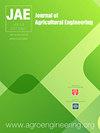Double-branch deep convolutional neural network-based rice leaf diseases recognition and classification
IF 2.5
4区 农林科学
Q2 AGRICULTURAL ENGINEERING
引用次数: 0
Abstract
Deep convolutional neural network (DCNN) has recently made significant strides in classification and recognition of rice leaf disease. The majority of classification models perform disease image recognitions using a collocation patterns including pooling layers, convolutional layers, and fully connected layers, followed by repeating this structure to complete depth increase. However, the key information of the lesion area is locally limited. That is to say, in the case of only performing feature extraction according to the above-mentioned model, redundant and low-correlation image feature information with the lesion area will be received, resulting in low accuracy of the model. For improvement of the network structure and accuracy promotion, here we proposed a double-branch DCNN (DBDCNN) model with a convolutional block attention module (CBAM). The results show that the accuracy of the classic models VGG-16, ResNet-50, ResNet50+CBAM, MobileNet-V2, GoogLeNet, EfficientNet-B1 and Inception-V2 is lower than the accuracy of the model in this paper (98.73%). Collectively, the DBDCNN model here we proposed might be a better choice for classification and identification of rice leaf diseases in the future, based on its novel identification strategy for crop disease diagnosis.基于双分支深度卷积神经网络的水稻叶片病害识别与分类
近年来,深度卷积神经网络(Deep convolutional neural network, DCNN)在水稻叶病的分类和识别方面取得了重大进展。大多数分类模型使用包括池化层、卷积层和全连接层在内的搭配模式进行疾病图像识别,然后重复该结构以完成深度增加。然而,病灶区域的关键信息是局部有限的。也就是说,如果只按照上述模型进行特征提取,会接收到与病灶区域相关的冗余、低相关性的图像特征信息,导致模型的精度较低。为了改进网络结构和提高准确率,本文提出了一种带有卷积块注意模块(CBAM)的双分支DCNN (DBDCNN)模型。结果表明,经典模型VGG-16、ResNet-50、ResNet50+CBAM、MobileNet-V2、GoogLeNet、EfficientNet-B1和Inception-V2的准确率均低于本文模型(98.73%)。总之,我们提出的DBDCNN模型基于其新的作物病害诊断识别策略,可能是未来水稻叶片病害分类和鉴定的更好选择。
本文章由计算机程序翻译,如有差异,请以英文原文为准。
求助全文
约1分钟内获得全文
求助全文
来源期刊

Journal of Agricultural Engineering
AGRICULTURAL ENGINEERING-
CiteScore
2.30
自引率
5.60%
发文量
40
审稿时长
10 weeks
期刊介绍:
The Journal of Agricultural Engineering (JAE) is the official journal of the Italian Society of Agricultural Engineering supported by University of Bologna, Italy. The subject matter covers a complete and interdisciplinary range of research in engineering for agriculture and biosystems.
 求助内容:
求助内容: 应助结果提醒方式:
应助结果提醒方式:


